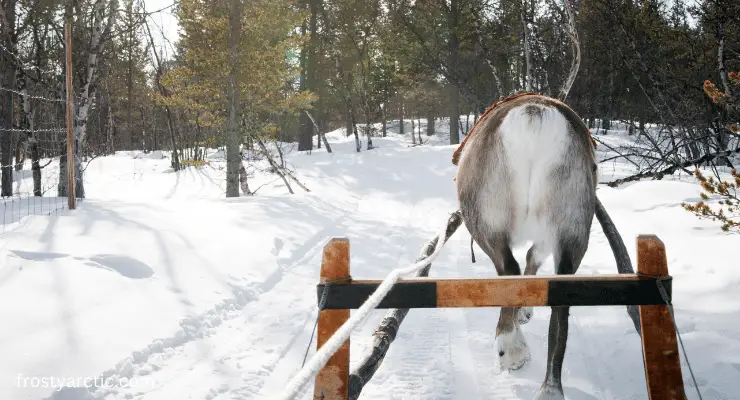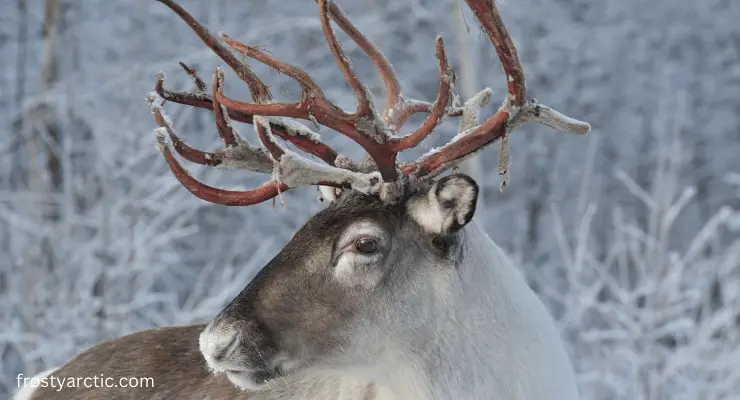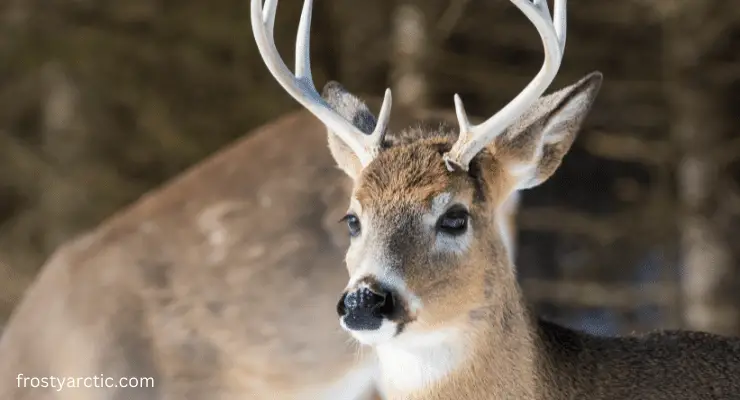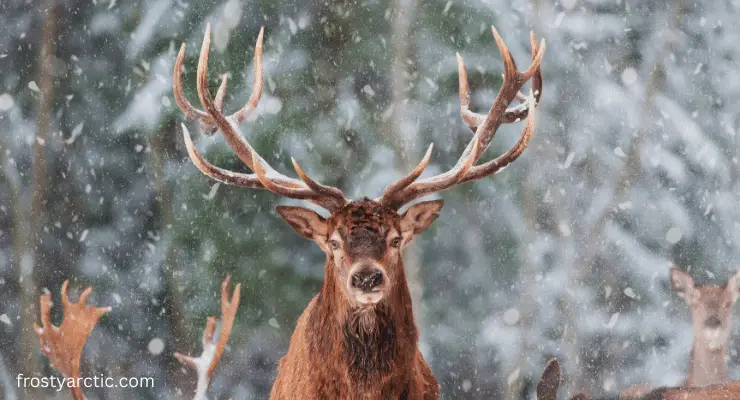Reindeers are lovely creatures that have symbolized Christmas for more than a century. When people think about a Reindeer, they often think of the reindeer pulling the sleigh of Santa Claus.
Interesting? Yeap! Reindeers are surrounded by plenty of interesting facts. But do you want to know the top interesting facts about reindeer?
Well, I found 20 facts about reindeer that seem interesting to me. Let’s talk about the top selected interesting facts about reindeer.
- Reindeer and Caribou are the same
- Reindeer can be domesticated
- Both females and males have antlers
- Female Reindeer’s lifespan vs male reindeer
- Reindeers’ lifespan
- They are herbivores
- Reindeer’s sound
- Male reindeer sound louder than female
- Reindeer’s shrinking hooves
- Exceptional features in their nose
- Reindeer’s smelling sense
- Wide range of predators
- Their eye colors
- Excellent swimmers
- Reindeer’s night vision
- Climate change harms reindeer
- Reindeer’s run
- Reindeer’s teeth
- Wide range of migration
- Parasites and insects on reindeer’s skin
The more you learn about reindeer, the more you become astonished. Their unique characteristics are fascinating. Let’s have a look at the brief discussion about reindeer.
Top 20 Interesting Facts About Reindeer and Caribou
1. Reindeer and Caribou Are Identical
Reindeer and caribou are the same animals from different subspecies.
Among the subspecies of this species, 7 are known as caribou, remaining are known as Reindeer.
Mostly, caribou are found in North America; on the other hand, in Russia and the surrounding Region, you will reindeer the most.
2. Reindeer Can Be Domesticated
You might know that Reindeer belong to the deer family Cerevidae. Most of the species of this family that live in the wild can’t be domesticated. But reindeer can be domesticated, and humans have been domesticating them since the stone and iron Ages.
In almost 9 countries, approximately 100,000 employees look after around 2.5 million domesticated Reindeer. Those reindeer are used mostly for transportation, food, clothing, etc., purposes.

3. Both Females and Males Have Antlers
In most of the species of the Cerevidae family, only male members have antlers. But both male and female reindeer possess antlers.
However, male reindeer have longer antlers than female members. Male antlers can grow up to 51 inches, whereas female antlers only reach up to 20 inches.
Also, their antlers fall and grow back taller every year. Male reindeer start to grow their antlers in February, which they shed in November. On the other hand, female members grow their antlers in May and keep them the whole winter.
4. Female Reindeer Live Longer Than Male Reindeer
You will be surprised to know that female reindeer have almost 4 years longer lifespans than male reindeer. But do you know why? In the wild, male members are most susceptible to predation, which is the main reason for their small lifespan.
Moreover, every year, the rutting season leaves a lot of stress on the male members’ bodies. As a result, reindeer lose plenty of weight. This weight loss weakens their immune system, so they become susceptible to plenty of sicknesses.
Also, they must pass through the harsh winter with their vulnerable body condition. Years after years, this weekend, body and weight also lessened their vitality. That’s why they live less than female Reindeer.
5. Reindeer Have a Greater Lifespan In Captivity
Generally, reindeer can live up to 15 years in the wild. Even if they live in a safe haunted environment, they still can’t live longer than that. On the other hand, in captivity, their average lifespan is 20 years. Do you know what the reason behind this difference is?
Those reindeer in captivity are always exposed to plenty of food throughout the year. Also, they are provided with safe and comfortable shelter, which protects them from harsh weather and their predators.
As they experience less environmental stress in captivity, their vitality also increases.
6. They Are Herbivores
Reindeer are committed herbivores. That means they mainly fed on plants. It is reported that they can eat almost 13 pounds of plants daily.
Their main diet list is the different types of lichen, mosses, grasses, leaves, ferns, shrubs, etc. Sometimes they also eat some supplementary food like mushrooms.
7. The Reindeer Makes a Sound Of Grunting
It’s said that Santa’s Reindeer can talk like a human. But, in the case of general reindeer, they cannot do so. They only can make sounds like grunting.
Sometimes, you will find them making sounds like barking or gas passing. Most interestingly, claves cry like human babies when they need something from their mothers.
8. Male Reindeer Sound Louder Than Female Reindeer
Reindeers have a pouch named the laryngeal pouch under the skin of their throat. This pouch is more well-developed in adult males than in adult female reindeer.

This pouch can create an amplified resonance in the vocal signal when inflated. These amplified frequencies made by their sound organ can be heard from a longer distance than female ones.
9. Reindeer’s Shrinking Hooves Give Them Great Mobility in Snow
Their shrinkable and expandable hooves make them adapted to move comfortably in any season. Also, their toes are extended away from each other. Thus, their body mass can be spread evenly, stabilizing the reindeer’s position on the wet ground.
Moreover, during winter, the ground becomes hard and icy. Also, reindeer’s footpads shrink and tighten, which helps in better grip on the hard ice.
However, in summer, their footpads expand to their normal condition. Then they can move comfortably on wet ground.
10. Exceptional Features in Their Nose
Reindeer’s nose is covered with hair and also has additional capillaries in their nose. Thus, the freezy breeze can’t enter their respiratory system directly.
Before going through their respiratory system, the fur of their nose helps in warming up the freezy wind. Therefore, this results in protecting the lungs from severe respiratory system infection.
Their nose is exposed to a lower temperature when they search for food below the ice. Luckily, extra capillaries in their nose boost the blood flow in their nose to keep it warmer
11. Reindeer Have an Excellent Smelling Sense
Reindeer’s smelling sense is so great that they can even identify their food lying underneath the ice.
Generally, you will find them moving around in windy weather. This type of weather is very helpful for them to pick up the smell.
Furthermore, they can even sense the danger by sniffing. Their sniffing power can lead them in the right direction also.
12. They Have a Wide Range Of Predators
Strong and healthy adult reindeer are capable of saving themselves from the diverse range of their predators. Normally, they move in huge herds, making it harder for predators to attack them.
Brown bears, Arctic foxes, mountain lions, gray wolves, coyotes, golden eagles, and lynxes are predators of young reindeer.
Moreover, humans also hunt reindeer for food, bones, and skin. Young reindeer are easier to prey on than those adult reindeer.
13. Their Eye Color Is Changeable
It’s quite interesting how the eye color of reindeer changes with the changing season. Their eyes are deep blue in winter, which turns golden in summer.
In the Arctic region, winter is way darker than summer. During summer, their eyes’ tapetum lucidum reflects the lights, making their eyes seem golden.
In winter, when the light level is low, this layer undergoes a complex transformation due to the change of light.
Thus, this transformation includes changes in the type of light that the tapetum can reflect. In consequence, their eyes seem blue in winter.
14. They Are Excellent Swimmers
Reindeer can swim at the speed of 4 miles per hour. If they are in a hurry, they can swim up to 6 miles per hour. Do you know why they can swim this excellently?
Reindeers have two layers of hair all over their body. One is the undercoat which is quite dense. Another one is the top layer of hollow hairs.
This layer is mainly air-filled and gives the ability to float nicely. Their hair layer is also used widely in life jackets.
15. Reindeer Have Great Night Vision
Reindeer can see better than humans at night. This is because they have an extra layer named tapetum lucidum behind their retina, which humans don’t have. That’s why reindeer can see those lights of wavelength 320 nm, whereas humans can’t see below 400 nm.

Even in lower light, reindeer’s retina and tapetum lucidum can reflect upcoming lights from objects. You might see reindeer’s eyeshine at night.
This occurs because of the reflection of light on tapetum lucidum. Precisely, double reflection tissue enhances their night vision.
They can see the light of ultraviolet ranges. Thus, they can see far away than humans, even things you can only smell.
16. Climate Change Harms Reindeer
Climate change is responsible for global warming, which causes ice melting. According to researchers, within the next 60 years, reindeer will lose up to 90% of their habitats.
In winter, as reindeer food is suppressed under the ice, they use their antlers to smash those ice layers. However, due to ice melting, the moisture level of those regions also increases. It causes rain and creates an extra hard layer over those soft ice layers.
Reindeers can’t break through this hard ice layer to get their food. Thus, they die of the scarcity of food. In 2013, almost 60,000 reindeer starved to death due to the effect of climate change.
17. Reindeer Can Run Faster Than Wolves
You will be surprised to know that reindeer can run within 90 minutes of their birth. Indeed, they have the great running ability. That’s why humans use their domesticated reindeer as a medium of transportation.
More interestingly, they can run faster than wolves. Generally, a wolf can run at 38 miles per hour. But a reindeer’s running speed can reach up to 70 miles per hour.
18. Their Teeth Can Indicate Their Age
Do you know you can assume the age of reindeer from the number of teeth in the jaw? Let’s have a look at the following table to understand their ages based on the number of their teeth:
| Numbers of teeth | Age |
| Less than four | Fawn |
| Four | 5-6 months |
| Five | Seven months -one year |
| Six | Over one year |
If the third tooth is of the same color as other teeth, then the age of the reindeer will be within 2.5 years.
With increasing age, the enamel of teeth will start to wear out. Also, the color of the teeth will look brown. The reindeer would be more than 5 years old if most teeth were worn out.
19. Wide Range of Migration
You may have seen reindeer in a group of 15 generally. But, during the spring, they make a group of almost 100,000 reindeer and migrate in search of food.
During the winter, their plant foods are suppressed underneath the ice. That’s why their food sources become scarce. If they keep staying at the same place, there is a high chance that they will die by starving.
Thus, they migrate in herds in search of food sources. They can move 3,000 miles during winter in search of food.
20. Parasites and Bloodsucking Insects on Reindeer’s Skin Are Terrifying For Reindeer
Every summer, many blood-sucking insects like mosquitoes, botflies, and deer botflies plague reindeer. This induced a great impact on calving behavior.
Also, many adult reindeer lost a lot of blood and lost their weight because of those bloodsucking insects.
Fly Larvae can cause parasitic infestations like myiasis. Those flies lay eggs on reindeer fur when hatched, larvae cause an infection on their skin. This disease can spread to humans from reindeer.
Conclusion
Reindeer are popular worldwide as the fictional sidekicks of Santa Claus. But you will also find real reindeer in polar and mountain regions. They are somewhat different from other deer family species, making them fascinating to people. If you have read this article, you already know many impressive actualities about reindeer.


